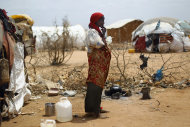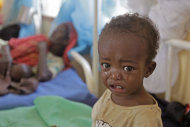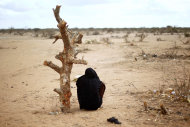Laurent Trabadello, Regional Manager for Africa and the Americas for our office in Canada, reports about the dire conditions on the ground and how Samaritan’s Purse is helping.
Not a drop of rain in three years! This is the current reality faced by the population of northeast Kenya. One doesn’t have to look far for the visible signs of this drought. The ground is parched, the trees are dry. The color green is conspicuous by its absence.

As we drive from the city of Garissa to the Somali refugee camps in Dadaab, the landscape is one of desolation. Occasionally, we see a caravan of donkeys and camels loaded with yellow plastic water containers.
Food Crisis in the Horn of Africa: Samaritan's Purse is distributing food to hungry families
The women who lead this procession are either walking to or returning from distant water distribution points. They sometimes have to walk 10-12 miles under the scorching sun to reach the nearest borehole.
Water is scarce. Wells are 500 feet deep and sometimes the water is salty. Water trucks will dump the precious liquid in tanks in remote communities, but we hear that the water is pumped straight out of the distant Tana River. What choice do people have?
Another sure sign of drought are the animal carcasses lining up the side of the road. Some have had a long time to rot, but others look like they have just fallen from exhaustion. Goats, cows, and even a giraffe remind us that a shortage of food and water inevitably lead to a slow death.
Dadaab surprises us by its sheer size. The giant refugee settlement is now home to more than 400,000 people, mostly Somali families who have escaped their own country with hopes of a better future in Kenya.
The political instability in Somalia has only exacerbated the effects of the drought, causing the United Nations to call the situation a famine. As a result, 2,000 new refugees cross into Kenya daily, slowly and painfully making their way from the border town of Liboi to the camps in Dadaab, located approximately 60 miles from the entry point.
This last stretch is undoubtedly the most challenging. People have been walking for weeks. They are hungry, thirsty, and exhausted from their exodus. Each story is different but the common thread is tragic. Many have lost children along the way, starved to death, with no other choice but to leave them behind. I don’t think any of us can fully understand the unimaginable sense of helplessness that a mother can feel when facing such tragic circumstances.
When these new arrivals finally make it to Dadaab, they receive a ration of food for 20 days, a tent, and medical attention. It’s not much, but it’s still more than some Kenyan communities in the corridor between Liboi and Dadaab are getting.
Much attention is given to the plight of the refugees, and rightly so, but the host communities of Kenya are not given much consideration. Yet they too face the devastating effects of the drought.
The percentages of children who are malnourished have soared. The nomadic cattle herders have lost their source of income, as animals have died and prices for livestock have plummeted, leaving them with insufficient means to provide adequate food for their families.
This is why Samaritan’s Purse has chosen to focus its efforts on helping the Kenyan communities in this area.
There are immediate needs, such as screening for malnourished infants and providing necessary supplements to nurse them back to health. We have found many health posts fully equipped to be used as feeding centers but with no one to run the programs. So, among other emergency interventions, Samaritan’s Purse will be training community health workers to run these needed programs and will supervise the work in a large area with many remote communities around Dadaab.
This is in addition to the food distributions that have already started, reaching needy families with maize, beans, oil, and sugar.
Working with Kenyan communities will also allow us to invest in their long-term future, helping them cope with recurring droughts. Better access to clean water, improved agricultural practices, and livestock restocking will allow beneficiary communities to face the future with greater confidence.
The needs are great, and the resources to implement these programs are insufficient. With your support we can extend the reach of our programs and add to the number of communities that will receive needed assistance.
As we leave Dadaab, heading back to Garissa, a few drops of rain hit the windshield. We see this as a sign of hope. However, many more drops of rain will be needed to quench the cruel thirst of this dry and weary land.
Will you join your prayers and support to these precious drops of life-giving water in a concerted effort to bring lasting hope to a people that have seen enough hardship?









